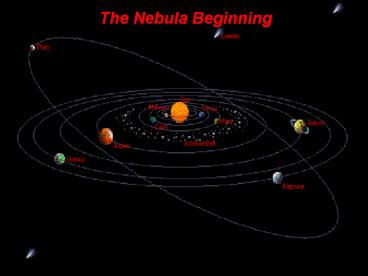The Nebula Beginning - PowerPoint PPT Presentation
1 / 9
Title:
The Nebula Beginning
Description:
This eerie, dark structure, resembling an imaginary sea serpent's ... These globules have been dubbed 'EGGs' -- an acronym for 'Evaporating Gaseous Globules' ... – PowerPoint PPT presentation
Number of Views:45
Avg rating:3.0/5.0
Title: The Nebula Beginning
1
The Nebula Beginning
2
The Nebula Beginning
3
The Nebula Beginning
M17
4
The Nebula Beginning
M1 The Orion Nebula
5
The Nebula Beginning
6
The Nebula Beginning
STELLAR "EGGS" EMERGE FROM MOLECULAR CLOUD
(Star-Birth Clouds in M16) This eerie, dark
structure, resembling an imaginary sea serpent's
head, is a column of cool molecular hydrogen gas
(two atoms of hydrogen in each molecule) and dust
that is an incubator for new stars. The stars are
embedded inside finger-like protrusions extending
from the top of the nebula. Each "fingertip" is
somewhat larger than our own solar system. The
pillar is slowly eroding away by the ultraviolet
light from nearby hot stars, a process called
"photoevaporation". As it does, small globules of
especially dense gas buried within the cloud is
uncovered. These globules have been dubbed "EGGs"
-- an acronym for "Evaporating Gaseous Globules".
The shadows of the EGGs protect gas behind them,
resulting in the finger-like structures at the
top of the cloud. Forming inside at least some
of the EGGs are embryonic stars -- stars that
abruptly stop growing when the EGGs are uncovered
and they are separated from the larger reservoir
of gas from which they were drawing mass.
Eventually the stars emerge, as the EGGs
themselves succumb to photoevaporation. The
stellar EGGS are found, appropriately enough, in
the "Eagle Nebula" (also called M16 -- the 16th
object in Charles Messier's 18th century catalog
of "fuzzy" permanent objects in the sky), a
nearby star-forming region 7,000 light-years away
in the constellation Serpens. The picture was
taken on April 1, 1995 with the Hubble Space
Telescope Wide Field and Planetary Camera 2. The
color image is constructed from three separate
images taken in the light of emission from
different types of atoms. Red shows emission from
singly-ionized sulfur atoms. Green shows emission
from hydrogen. Blue shows light emitted by
doubly- ionized oxygen atoms. Credit Jeff
Hester and Paul Scowen (Arizona State
University), and NASA
7
The Nebula Beginning
8
The Nebula Beginning
GIANT STARBIRTH REGION IN NEIGHBORING GALAXY
This is a Hubble Space Telescope image (right)
of a vast nebula called NGC 604, which lies in
the neighboring spiral galaxy M33, located 2.7
million light-years away in the constellation
Triangulum. This is a site where new stars are
being born in a spiral arm of the galaxy. Though
such nebulae are common in galaxies, this one is
particularly large, nearly 1,500 light-years
across. The nebula is so vast it is easily seen
in ground-based telescopic images (left). At
the heart of NGC 604 are over 200 hot stars, much
more massive than our Sun (15 to 60 solar
masses). They heat the gaseous walls of the
nebula making the gas flouresce. Their light also
highlights the nebula's three-dimensional shape,
like a lantern in a cavern. By studying the
physical structure of a giant nebula, astronomers
may determine how clusters of massive stars
affect the evolution of the interstellar medium
of the galaxy. The nebula also yields clues to
its star formation history and will improve
understanding of the starburst process when a
galaxy undergoes a "firestorm" of star formation.
The image was taken on January 17, 1995 with
Hubble's Wide Field and Planetary Camera 2.
Separate exposures were taken in different colors
of light to study the physical properties of the
hot gas (17,000 degrees Fahrenheit, 10,000
degrees Kelvin). Credit Hui Yang (University
of Illinois), Jeff J. Hester (University of
Arizona) and NASA.
9
The Nebula Beginning































